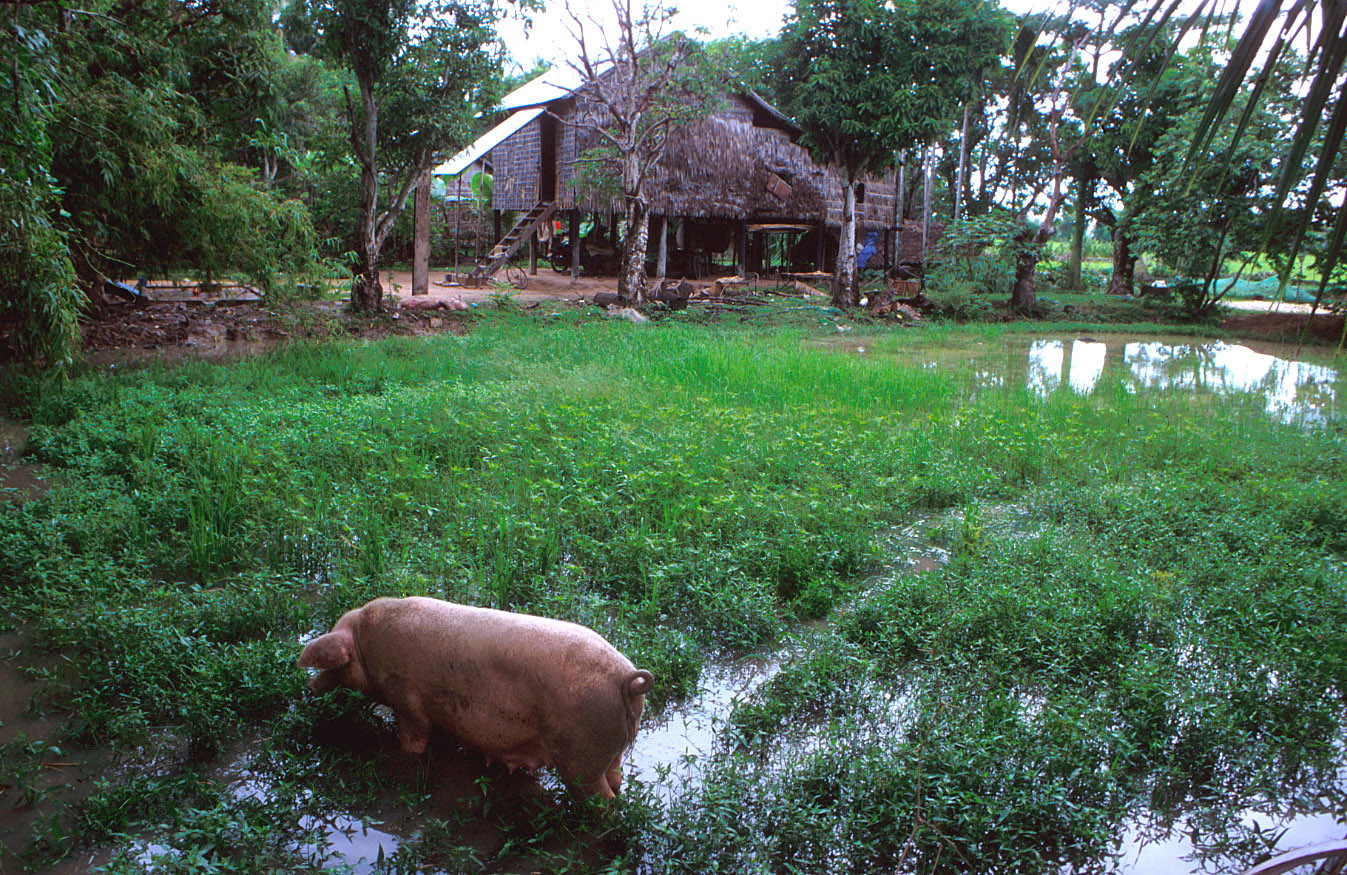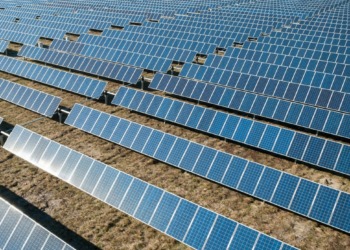The term “sustainable agriculture” has been in use since the late 1980s, and, although interpretations vary, it is usually understood as the adoption of practices and technologies that improve productivity without harming the environment. However, the level at which countries prioritize the use and conservation of natural resources for food production in their development agenda varies greatly, and, social and economic issues have been mostly neglected. Now we are at an important crossroad, and a cross-sectoral and holistic approach for sustainability must be a priority in the agenda for agricultural development. This must not only be driven by countries, with the support of the international community, but also by different key stakeholders in countries. Only then can we move towards more sustainable agriculture.
Nowadays we produce enough food to end hunger and achieve food security, but the main challenge remains, which is to provide access to food for all and to produce more food where it is needed, with the resources available. The problem is, however, that still about 30 percent of the food produced is lost or wasted.
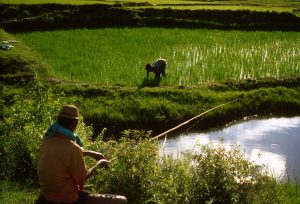
IN THE PHOTO: Madagascar – Rice production and fish farming. Man fishing while a farmer weeds the nearby rice field. PHOTO CREDIT: FAO/Jeanette Van Acker
Another challenge is ensuring good quality of healthy food, considering that issues of hunger, micronutrient deficiencies, overweight and obesity are becoming even higher in the global agenda after the 2nd International Conference on Nutrition (ICN2), which was held in Rome in 2014. Income growth and urbanization in low- and middle-income countries are also shifting the consumer preference towards greater consumption of meat, fruits and vegetables and away from a cereal-based diet.
We produce enough food to end hunger and achieve food security, but the main challenge remains, which is to provide access to food for all and to produce more food where it is needed, with the resources available.
The fact is that the way we produce most of our food is not sustainable. This is coupled with an unprecedented confluence of challenges that food and agriculture are currently facing. There is still a need to increase food production by an estimated 50 percent by 2050 in relation to 2012 (FAO, 2016), to feed the population of over nine billion people. Nearly 80 percent of the world’s extremely poor people – about 700 million, including landless workers, smallholder family farmers, pastoralists, fisherfolk and indigenous peoples – live in rural areas of developing countries, and their livelihoods almost entirely depend on agriculture. Natural resources are shrinking: 33 percent of land is already moderately or highly degraded, water resources are overexploited, and deforestation and overfishing are damaging ecosystems and biodiversity.
To make matters worse, climate change has intensified natural hazards and has subsequently had an impact on food production. Between 2003 and 2013, the agriculture sector accounted for about 22 percent of damages caused by natural threats and disasters in developing countries (FAO, 2015). Climate change also affects food availability through its increasingly adverse impacts on crop yields, fish stocks, animal health and productivity, especially in sub-Saharan Africa and South Asia.
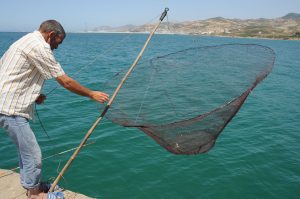
IN THE PHOTO: A fisherman fishing at Ksar Sghir Port, 11 July 2012, Tangier, Morocco. PHOTO CREDIT: FAO
Nevertheless, over the past few years, we have witnessed a number of positive initiatives emerge. New transformative global agendas, such as the 2030 Agenda, the Paris Climate Agreement, the Sendai Framework for Disaster Risk Reduction and the Addis Ababa Action Agenda, might help to address the aforementioned challenges.
For instance, the 2030 Agenda covers a wide array of issues across 17 Sustainable Development Goals (SDGs) to achieve sustainable development. It is based on principles of universality (as it involves all countries, rich and poor), indivisibility (the Agenda focuses on several goals simultaneously) and inclusivity (since its implementation requires a multi-stakeholder approach, including the private sector and civil society). For instance, SDG 2 explicitly aims at ending hunger, achieving food security and improving nutrition, while simultaneously promoting sustainable agriculture. Thus, when approached comprehensively, SDG 2 cuts across many SDGs, in particular SDG 1 (no poverty), SDG3 (health and well-being); SDG 5 (gender equality), SDG 6 (water), SDG 8 (decent work and economic growth), SDG 10 (inequality), SDG 12 (responsible production and consumption), SDG 13 (climate action), SDG 14 (oceans), SDG 15 (ecosystems, biodiversity and forests) and SDG 16 (peaceful societies).
Natural resources are shrinking: 33 percent of land is already moderately or highly degraded, water resources are overexploited, and deforestation and overfishing are damaging ecosystems and biodiversity.
The Paris Climate Agreement is a global treaty that seeks to limit climate change through adaptation and mitigation (decrease in greenhouse gas emissions). The Sendai Framework for Disaster Risk Reduction outlines seven clear targets and four priorities for action to prevent new and reduce existing disaster risks. And the Addis Ababa Action Agenda is a framework for financing development.
Together these global objectives are expected to guide the actions of the international community over the next 13 years (2017-2030), and they should be implemented in a complementary and synergistic manner. They are designed to tackle the large global developmental challenges, with the ultimate ambition of ending poverty, hunger and malnutrition and responding to climate change, while achieving inclusive growth, building resilient communities and sustainably managing our natural resources.
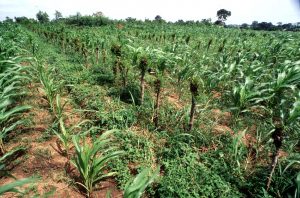
IN THE PHOTO: Hedgerow intercropping. PHOTO CREDIT: FAO
Food and agriculture are at the heart of these agendas, but the aforementioned challenges can only be overcome if communities are prioritised and if a ‘business-as-usual’ approach is abandoned.
The Food and Agriculture Organization (FAO) has developed a common vision for sustainable food and agriculture, based on five principles:
1) Improved efficiency in the use of resources;
2) Conservation, protection and enhancement of natural resources;
3) Improved rural livelihoods and social well-being;
4) Enhance resilience of people, communities and ecosystems to climate change and threats;
5) Responsible and effective governance mechanisms.
The vision addresses the three pillars of sustainability: social, economic and environmental. Those principles are fully in line with all the global agendas and, as such, should be implemented altogether and in a synergistic way; have the process driven by countries; be cross-sectoral; be managed through a multi-stakeholder approach; be adaptable to changing demands; and be results-based. However, it is always important to keep in mind that sustainability has no end-point: it should be seen as a continuous and evolving process.
Humans depend in many ways on ecosystems and their services for basic needs: agrobiodiversity including genetic resources, clean water, shelter, food and raw materials.
Moreover, ecosystems regulate our environment and production systems: pollination through wild bees, insect-pest and disease control through natural enemies, water purification through trees and forests, and soil fertility maintenance through nutrient cycling and nitrogen-fixing plants – those are just a few ecosystem services that support the functioning of agro-ecosystems in both terrestrial and aquatic environments. These are just some examples of how implementing sustainable food and agriculture programs span across sectors and therefore require an integrated approach. From an environmental point of view, landscape (territorial) management has been successfully applied and should be considered because it helps to integrate agriculture, forestry and fish production with natural resources management and conservation, as well as identify trade-offs and synergies among the different principles of sustainable food and agriculture, including special focus on people and communities.

IN THE PHOTO: Pigs in a rice paddy where they provide fertilization. PHOTO CREDIT: FAO
In addition, it is clear that further work needs to be done to spread awareness about sustainable agriculture production. Political support is indispensable to create a welcoming environment for sustainable food and agriculture at a country level. Without a strong political will to introduce changes and ensure policy support, transformations will not be implemented.
Some key drivers of transition towards sustainable agriculture are presented here below, keeping in mind the five principles of sustainable food and agriculture, the three pillars of sustainability and a cross-sectoral and holistic approach. If implemented together with strong national support, they can pave way to a more sustainable food and agriculture:
1) Innovative and adequate policies and incentives (such as regulations, taxes, subsidies, pro-poor social protection, payment for conservations of ecosystem services and biodiversity, land tenure, and access to the market that can increase income and livelihoods for the rural population, particularly for those that are highly dependent on agriculture).
Special attention should be given to gender equality, youth employment and income diversification. Policy coherence and integration requires structural changes in the way policies are formulated and implemented, with the engagement of new stakeholders from the private sector and civil society as well as from local communities.
2) Research & Development & Innovation (R&D&I) to promote climate change adaptation and mitigation, sustainable intensification with efficient use of resources, conservation of ecosystem services and biodiversity and access by smallholder family producers. The research agenda needs to evolve from being centrally developed to include stakeholder’s participation; from production increases to sustainable food systems, integrating social, economic and environmental components; from farm to value chains and a territorial approach; from supply of technologies to co-developing innovation with multi-actor networks; and from reductionist to systemic and interdisciplinary (Tropical Agriculture Platform 2016). Therefore, integrated agricultural production systems (i.e. agro-forestry, agroecology, crop-livestock, agrosilvopastoralism, crop-fish, etc.) should be a priority in the R&D&I agenda, with a strong emphasis on ecosystem management and conservation of natural resources. They generate positive impacts on the environment and resilience to climate change as well as nutrition through diet diversification.
3) Investments and financial aid in support of ending hunger, improving nutrition and promoting sustainable agriculture and food systems.
The majority of investments in agriculture come from farmers. Therefore working directly with producers and responding to their needs would facilitate the development of financial products that can foster sustainable agriculture production in all sectors. For instance, promoting credit cooperatives may facilitate smallholder producers’ access to financing and allow inputs, energy and natural resources to be used in a more ecological manner. Public investments in rural infrastructure and in developing innovative markets can improve income and livelihoods for poor farmers.
4) Improved governance and institutions for inclusive food systems
In conclusion, to implement the new challenges facing sustainability, innovative governance mechanisms and institutions are necessary at national and sub-national levels. This means that sustainable agriculture food systems should no longer be developed solely by the Ministry of Agriculture but through cross-ministerial coordination. Moreover, new structures and mechanisms are required to promote a multi-stakeholder dialogue with the participation of non-traditional parties, such as private companies, consumers, non-governmental organizations and producers with the aim of formulating and implementing public instruments and regulations in a holistic and coherent way.


